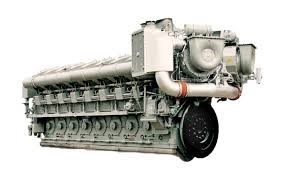By Correctly Diagnosing a Diesel Generator Maintenance Problem, LCE Helps the Navy Create a Fleet-wide Fix
Naval Surface Warfare Center, Philadelphia Division (NSWCPD) provides the Navy's primary technical expertise and facilities for both naval machinery research and development and naval machinery lifecycle engineering. NSWCPD is responsible for the machinery systems core equity of the Ship and Ship Systems Product Area for the United States Navy and serves as a central point for academia and industry to join forces with Navy technical experts to develop solutions to needs in naval machinery. Consistent with its core equity responsibility, NSWCPD fulfills key functions including research, design, development, shipboard and land-based test and evaluation, acquisition support, in-service engineering, Fleet engineering, integrated logistics support and concepts, and overall life cycle engineering.
LCE Helps Navy Ships Perform the Right Maintenance at the Right Time
Life Cycle Engineering directly supports the Diesel Maintenance Strategy (DMS) program that was established to reduce the growth in diesel engine work performed within ship availabilities and perform the right maintenance at the right time. Main Propulsion and Ships Service Diesel Engines are included within the strategy:
- Improve Navy efficiency with availability planning and execution
- Investigate the root cause of diesel engine availability growth work
- Provide recommended actions to reduce diesel engine growth work
- Ensure all parts are on hand prior to entering the availability, reducing long lead-time material cost
- Perform the correct maintenance based on engine condition
- Utilize standardized work specifications
- Plan engine maintenance according to the established DMS Life Cycle Maintenance (LCM) matrix
An Amphibious USN ship recently executed a Continuous Maintenance Availability (CMAV) which included planned DMS Life Cycle Maintenance actions to the Main Propulsion and Ships Service Diesel Engines.
Replacing Diesel Generator Fuel Injectors Results in Lubrication Problems and Places the Engine Out of Service
One of the Ship’s Service Diesel Generator (SSDG) fuel injectors were scheduled for replacement in accordance with the DMS Life Cycle Maintenance Plan operating hours’ time-based service life. The fuel injectors were replaced following the onboard, approved Technical Manuals and the associated Preventive Maintenance System (PMS) Maintenance Requirements Card (MRC).
Once maintenance was completed, an operational test was conducted to certify the accomplished work. As required by onboard Engineering Operational Procedures (EOP) and PMS, a lube oil sample was drawn and tested; the results indicated high fuel oil dilution to the lubricating oil, placing the engine in a restricted, out-of-service condition.
Ship’s Force asked the assigned LCE SEA Coach DMS Diesel Lifecycle Engineering Representative (DLER) to help determine the root cause of lube oil fuel dilution and to validate the maintenance procedures used to complete the fuel injector replacements.

Root Cause Diagnosis Uncovers Unsuitable Replacement Parts and Yields a Fleet-wide Fix
After discussion with Ship’s Force personnel, the SSDG was tagged out in accordance with onboard Engineering directives and the LCE SEA Coach helped the onboard maintenance personnel inspect the engine to determine the root cause of fuel oil dilution of the lube oil. They concluded that fuel was leaking from all six fuel injector bodies into the cylinder heads, then draining into the engine lube oil sump, resulting in the lube oil fuel dilution.
The LCE SEA Coach then assisted Ship’s Force with a review of the onboard Technical Manuals and the associated Maintenance Requirements Card procedures. Comparing the onboard procedures with the most recent Original Equipment Manufacturer (OEM) technical documentation provided by Caterpillar revealed that the onboard procedures were obsolete and had not been updated to meet the OEM installation procedures. Furthermore, a comparison of the O-ring software materials used during the fuel injector replacements with the OEM list of approved materials showed that even though the supply system-issued O-rings were in accordance with onboard supply parts provisioning documentation, they were not an approved suitable replacement for the OEM O-Rings.
The root cause of the fuel migrating past the injector bodies into the engine was due to the use of non-approved, unsuitable replacements for the OEM O-rings. The sub-standard O-rings allowed fuel to leak by due to insufficient sealing area at the injector body to the cylinder head fuel cavity.
Ship’s Force procured the correct OEM-approved fuel injector O-rings, and with assistance from the LCE SEA Coach representative, conducted the removal and O-ring changeouts in accordance with the correct OEM technical procedures. Ship’s Force removed the contaminated lube oil and replenished with new oil, installed new lube oil filters, and then operationally tested the SSDG. All observed operating conditions reported normal within specified operating parameters. After successful operational testing, a lube oil sample was drawn and tested normal with no fuel dilution. The SSDG was placed back into operational service with no restrictions.
The LCE SEA Coach briefed the Engineering department and provided all findings to the NSWCPD ISEA Team Lead for submission of Technical and Supply provisioning feedback reports. The findings will correct the obsolete technical documentation and address the procurement of the non-suitable aftermarket O-rings throughout the Fleet.

To learn more about LCE's Sea Coach Services,
please visit our website.
 By Correctly Diagnosing a Diesel Generator Maintenance Problem, LCE Helps the Navy Create a Fleet-wide Fix.pdf
By Correctly Diagnosing a Diesel Generator Maintenance Problem, LCE Helps the Navy Create a Fleet-wide Fix.pdf